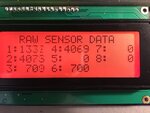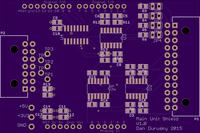TXBDan
Junior Member level 1
Hi all,
I'm working on a project that requires 8 ADC channels and so am using a Microchip MCP3208.
The first four channels are measuring variably resistive loads (temp/pressure sensors) and so have an optional 5V pullup. I thought I would be clever and use an opamp buffer and an RC filter on each channel to provide a good low impedance source and some noise filtering. This is the circuit for one channel:

I spun a PCB with the design and am interfacing to an mbed microcontroller using the SPI interface. I'm using proven software libraries that should work.
The problem I'm seeing is that at random, some of the channels will start dropping voltage at the ADC input. The longer I let the device run the worse it gets. Sometimes all will seem normal for awhile, but then one or two channels will start to drop. The voltage at the ADC input will be pulled up to 5V, yet it can slowly drop to as low as 0.3V verified by multimeter.
So for some reason the ADC is pulling some current and I'm dropping voltage over the 2.2k RC resistor. I have a suspicion that my RC is bogging down the charge time of the ADC's capacitor and maybe things aren't ever charging and thus requiring constant current?
After doing more research, maybe my RC values are way too high.
Any input would be greatly appreciated.
(I'd also like to redesign this to use a 4.096V reference for both the ADC VREF and for the pullups, my 5V line is noisier than I anticipated.)
- - - Updated - - -
I should also add that SENS1_IN comes from the resistive sensor (sensor between SENS1_IN and GND) and SENS1 goes to the ADC input.
I'm working on a project that requires 8 ADC channels and so am using a Microchip MCP3208.
The first four channels are measuring variably resistive loads (temp/pressure sensors) and so have an optional 5V pullup. I thought I would be clever and use an opamp buffer and an RC filter on each channel to provide a good low impedance source and some noise filtering. This is the circuit for one channel:

I spun a PCB with the design and am interfacing to an mbed microcontroller using the SPI interface. I'm using proven software libraries that should work.
The problem I'm seeing is that at random, some of the channels will start dropping voltage at the ADC input. The longer I let the device run the worse it gets. Sometimes all will seem normal for awhile, but then one or two channels will start to drop. The voltage at the ADC input will be pulled up to 5V, yet it can slowly drop to as low as 0.3V verified by multimeter.
So for some reason the ADC is pulling some current and I'm dropping voltage over the 2.2k RC resistor. I have a suspicion that my RC is bogging down the charge time of the ADC's capacitor and maybe things aren't ever charging and thus requiring constant current?
After doing more research, maybe my RC values are way too high.
Any input would be greatly appreciated.
(I'd also like to redesign this to use a 4.096V reference for both the ADC VREF and for the pullups, my 5V line is noisier than I anticipated.)
- - - Updated - - -
I should also add that SENS1_IN comes from the resistive sensor (sensor between SENS1_IN and GND) and SENS1 goes to the ADC input.
Last edited by a moderator:

